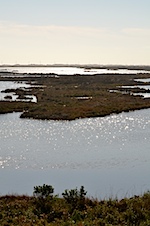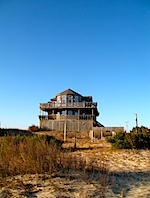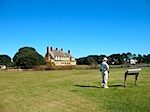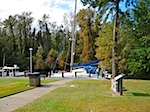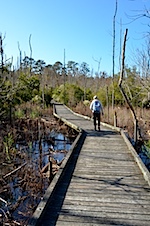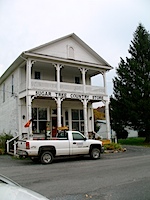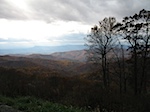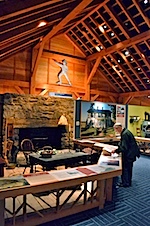Tide, Wind and Thin Water
As we drove into North Carolina, through Elizabeth City and west towards (Historic) Bath (NC), we kept noticing that the tidal creeks were very full, and like good Yankees assumed that that meant the tide was high. Except it seemed unusually high, lapping over the bottoms of trees and over grassy points, and it wasn’t the new moon.
Next day we visited the Estuarium at Washington, a really interesting museum dedicated to explaining the dynamics of Pamlico (and Albemarle) Sound(s). In the course of the visit we asked what the average range of the tides in the Sound is, and got one of those fun reactions that makes you realize you are REALLY out of your range:
Essentially, there are no tides in the Sound; the outer banks being such a complete barrier, with few inlets, block any tidal effect. The wind rules: an easterly blows the water up into the rivers and creeks on the west side of the sound, and westerlies reverse the process. What we were seeing was the effect of a NE wind that was blowing hard and steadily. In New Bern, it pushed the tide up into the low-lying streets by the harbor. In hindsight, it seems to me that this is the sort of thing that everyone must know and we were just behind the eightball.
Here’s where it gets even more interesting. We know that Irene, in August this summer, passed inland of the outer banks, so picture the wind pattern:
- The leading edge, rotating CCW, blows the water of the sound all into the western ends of the sound, and in serious quantities: water was often 10 – 15 feet above its usual levels.
- As the eye passes the sound, the wind reverses and blows all that water back east, against the outer banks. The result was a huge wash-over from inside the sound over the banks in a seaward direction. The new inlet that it breached just south of Oregon Inlet, was blown through from the inside of the banks, towards the ocean. The pressure of that wind-driven tidal wave with no room for it to escape through the two or three inlets meant that it created a whole new inlet and washed across the banks from inside toward the ocean. Apparently so much water poured through Oregon Inlet that it scoured it out far more effectively than any number of Corps of Engineers dredges.
- For an image of how this works, consider a big washtub filled to about 4″ from the top; pick one end up slowly until the water reaches the edge, then drop the edge you’ve picked up; what happens? That water essentially runs downhill and all slops over the end you dropped. Scale this up to 3000 sq. miles of water, pushed by hurricane force winds, and you begin to get a sense of the scale.
Add to this that Pamlico Sound is essentially nowhere more than about 20 feet deep, and you can begin to grasp what happens when the wind blows at hurricane force across the ocean-equivalent of a puddle 1″ deep.
It’s hard to grasp how thin the water out there is. Here are some images of the GPS track of the ferry from the southern tip of Ocracoke SE to Cedar Island (the ferry track is marked by the orange hyhen line); note the soundings from the NOAA ENC charts: 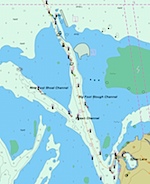



This is written in Beaufort, NC, a really lovely town, full of ICW boats of every shape, persuasion and condition. Here there is a diurnal tide, with an average height of 2 – 3 feet, according to our local informant, the skipper of the skiff who ran us out to Shackleford Bank. He has a 100 ton Master’s license and was running us about in a 23 foot flats skiff. Tagged Ocracoke, Outer Banks, Pamlico Sound





